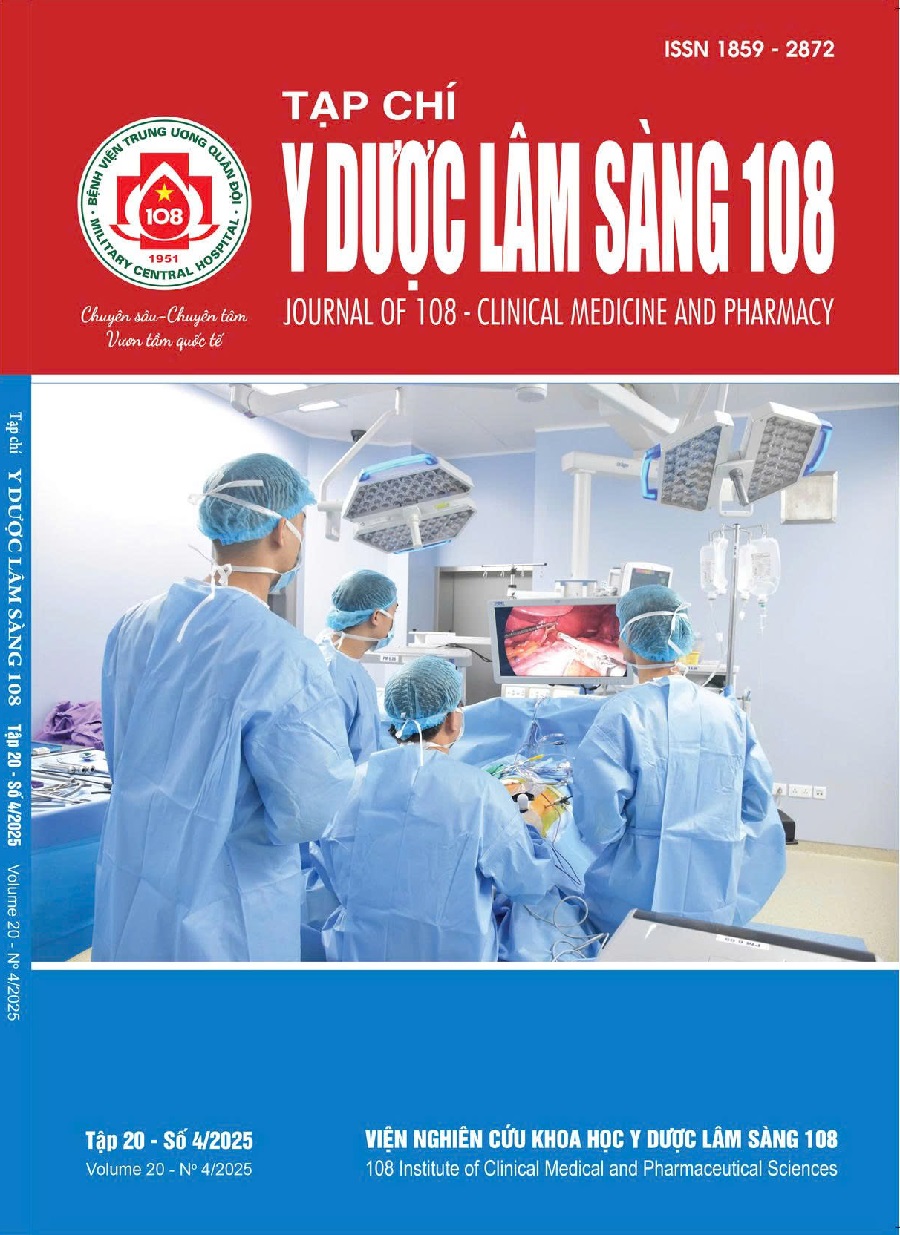The results of Laparoscopic gastrectomy with D2 lymphadenectomy using Indocyanine Green for radical gastric adenocarcinoma
Main Article Content
Keywords
Abstract
Objective: To evaluate the outcomes of laparoscopic gastrectomy with D2 lymphadenectomy using Indocyanine Green (ICG) in the treatment of gastric adenocarcinoma. Subject and method: A prospective descriptive study was conducted at the 108 Military Central Hospital from August 2021 to December 2024. Patients received submucosal endoscopic injections of ICG on the day before surgery. During the operation, a fluorescence imaging system was employed to guide standard D2 lymphadenectomy. Result: A total of 81 patients underwent laparoscopic subtotal gastrectomy with D2 lymphadenectomy guided by ICG fluorescence imaging. The pathological tumor stages in the cohort were pT1 (36%), pT2 (27%), pT3 (20%), and pT4a (17%). Lymph node metastasis was observed in 35.8% of patients. The mean distance from the proximal resection margin to the tumor was 5.5 ± 1.9 cm, with negative histological results for both proximal and distal margins in all cases. No cases required conversion to open surgery. The mean time to gastrointestinal recovery was 3.1 days, and the average postoperative hospital stay was 7.9 ± 2.1 days. Early postoperative complications were observed in 11.1% of cases. Postoperative recurrence occurred in 9 patients (11.1%). The mean follow-up periods for overall survival (OS) and disease-free survival (DFS) were 25.5 ± 8.2 and 24.4 ± 8.5 months, respectively. The estimated 3-year OS rate was 82.7%. The 2-year and 3-year OS rates for stage II patients were 100% and 88.9%, respectively, and for stage III patients, they were 83.6% and 46.4%, respectively. Conclusion: Laparoscopic gastrectomy with D2 lymphadenectomy using ICG for gastric adenocarcinoma treatment is a safe surgical method associated with a low rate of complications.
Article Details
References
2. Kim TH, Kong SH, Park JH, Son YG et al (2018) Assessment of the completeness of lymph node dissection using near-infrared imaging with indocyanine green in laparoscopic gastrectomy for gastric cancer. J Gastric Cancer 18(2): 161-171.
3. Chen QY, Zhong Q, Liu ZY et al (2023) Indocyanine green fluorescence imaging-guided versus conventional laparoscopic lymphadenectomy for gastric cancer: Long-term outcomes of a phase 3 randomised clinical trial. Nature communications 14(1): 7413.
4. Jung MK, Cho M, Roh CK et al (2021) Assessment of diagnostic value of fluorescent lymphography-guided lymphadenectomy for gastric cancer. Gastric Cancer 24(2): 515-525.
5. Chen QY, Zhong Q, Li P et al (2021) Comparison of submucosal and subserosal approaches toward optimized indocyanine green tracer-guided laparoscopic lymphadenectomy for patients with gastric cancer (FUGES-019): A randomized controlled trial. BMC medicine 19(1): 276.
6. Hồ Chí Thanh (2016) Nghiên cứu kết quả phẫu thuật nội soi hỗ trợ cắt bán phần dưới dạ dày tại bệnh viện Quân y 103. Luận án Tiến sĩ. Học viện Quân Y.
7. Adachi Y, Oshiro T, Mori M et al (1997) Tumor size as a simple prognostic indicator for gastric carcinoma. Annals of surgical oncology 4(2): 137-40.
8. Chen QY, Xie JW, Zhong Q et al (2020) Safety and Efficacy of Indocyanine Green Tracer-Guided Lymph Node Dissection During Laparoscopic Radical Gastrectomy in Patients With Gastric Cancer: A Randomized Clinical Trial. JAMA Surgery 155(4): 300-311.
9. Zhao J, Li K, Wang Z et al (2022) Efficacy and safety of indocyanine green tracer-guided lymph node dissection in minimally invasive radical gastrectomy for gastric cancer: A systematic review and meta-analysis. Frontiers in oncology, 12.
10. Huscher CG, Mingoli A, Sgarzini G et al Laparoscopic versus open subtotal gastrectomy for distal gastric cancer: Five-year results of a randomized prospective trial. Annals of surgery 241(2): 232-237.
11. Kitano S, Shiraishi N, Uyama I et al (2007) A multicenter study on oncologic outcome of laparoscopic gastrectomy for early cancer in Japan. Annals of surgery 245(1): 68-72.
12. Chen K, Mou YP, Xu XW et al (2014) Short-term surgical and long-term survival outcomes after laparoscopic distal gastrectomy with D2 lymphadenectomy for gastric cancer. BMC Gastroenterology 14(1): 41.
13. Park SH, Kim KY, Cho M et al (2023) Prognostic impact of fluorescent lymphography on gastric cancer. International journal of surgery (London, England) 109(10): 2926-2933.
 ISSN: 1859 - 2872
ISSN: 1859 - 2872
